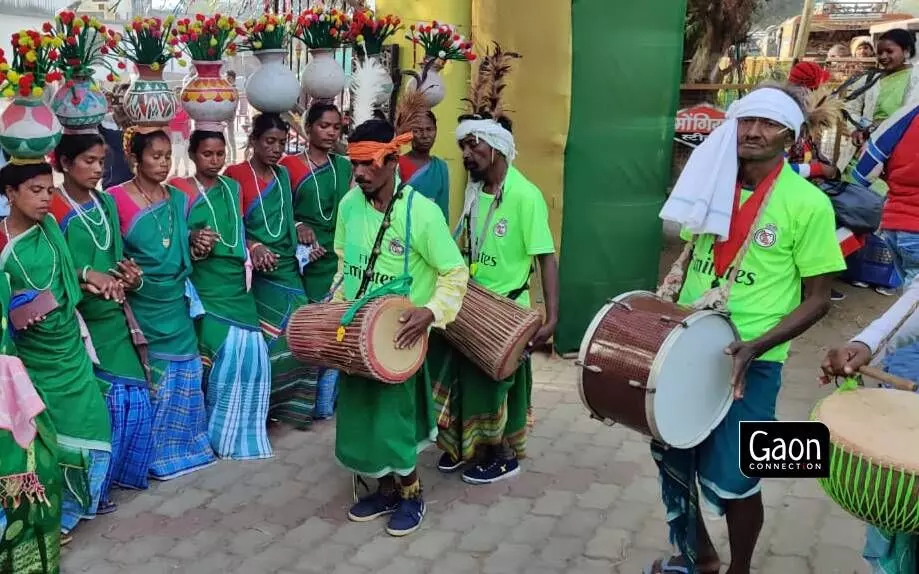A Day After Diwali, Santhal Tribe Celebrates Sohrai Porab to Honour Its Cattle
While Diwali celebrates the return of Lord Rama to Ayodhya, Sohrai Porab celebrates the return of the cattle to their village. Villagers in Jharkhand worship the cows by decorating them, lighting lamps, singing songs and offering pujas.
 Manoj Choudhary 11 Nov 2023 7:34 AM GMT
Manoj Choudhary 11 Nov 2023 7:34 AM GMT

While Diwali celebrates the return of Lord Rama to Ayodhya from 14 years of exile, Sohrai Porab celebrates the return of the cattle to the tribal villages.
East Singhbhum, Jharkhand
Somai Jhopri village in East Singhbhum district is busier than usual. People are busy cleaning the inside and outside of their homes, and painting its mud walls with natural colours in anticipation of Sohrai Porab, a festival of the Santhal tribal community of Jharkhand.
Sohrai Porab falls on the day after Kartik Amavasya when the festival of lights, Diwali, is celebrated across India with people lighting earthen lamps and relishing sweets. This year, Diwali is set to be celebrated on November 12 and Sohrai Porab on November 13.
The Santhali festival is celebrated for five days and villagers venerate and offer prayers to cattle that play a huge role in their daily lives.
“We hold cattle dear to us. They are like family members and no one is allowed to mistreat them. They are worshipped on Sohrai Porab for their pivotal role in cultivation, transportation, milk, in our lives,” Dhano Mardi, a resident of Somai Jhopri, told Gaon Connection.
The villager went on to inform that all the inhabitants decorate their houses with Sohrai art, depicting the Santhal tribal culture and tradition. “We paint our walls with natural colours made out of the produce of the forest and rice flour,” Dhano Mardi said pointing to Sona Mardi who along with her brothers and sisters carefully paint flowers, cattle, birds on their walls. Forests and wildlife are dear to the Santhali traditions.
So close to themselves are the cows for the Santhalis that they give each cow a name, just as they would their children.
Also Read: A Day After Diwali, a Village in Madhya Pradesh Observes a Unique Festival to Honour Cows
Genesis of Sohrai
Like it is with all traditions and rituals that have come to stay, there is a story behind Sohrai Porab too.
“Cows and bulls were indispensable to tribal life since time immemorial. They ploughed the fields, transported goods to-and-fro and were integral to survival. But gradually, people began to ill-treat them, and showed them no love or respect,” Mangal Kisku, a resident of Somai Jhopri, narrated to Gaon Connection.
“The tribal Gods noticed, and decided to teach the people a lesson. They drove all the cattle away from the habitations into the deep forests and hills. Without their cattle, the people were now stranded. Agriculture ground to a halt… Remorseful, the people begged for forgiveness and promised to always revere the cows and bulls if they returned to the villages. The following day, the cattle returned home,” Kisku said happily.
While Diwali celebrates the return of Lord Rama to Ayodhya from 14 years of exile, Sohrai Porab celebrates the return of the cattle to the tribal villages.
People are busy cleaning the inside and outside of their homes, and painting its mud walls with natural colours in anticipation of Sohrai Porab,
Also Read: Baghelkhand's unique tradition of Mount Govardhan and Janjuiya Devi Puja
Customs and celebration
On the first day of the festival, which falls a day after Diwali, the cows in the village are gathered after a day of grazing in an open field. Villagers worship them by lighting lamps, singing songs and offering pujas. The cows are decorated with oil, vermilion, etc.
On the second day, married daughters visit their parents to celebrate the festival. Horns of the cows are decorated elaborately with paddy. On the third day, cows and bulls are left free to graze and roam.
All the inhabitants decorate their houses with Sohrai art, depicting the Santhal tribal culture and tradition.
On the penultimate day of the festival, the Santhali people sing, dance and make merry. On the final day, villagers assemble to find out if anyone has been guilty of mistreating cattle in the village. The guilty are chastised and made to apologise and promise that they will not do so again.
Also Read: Celebrate Diwali with homemade sweets and savoury snacks recipes
Parmila Kisku, a Santhali teacher at the Utkramit Madhya Vidyalaya Ranidih village in East Singhbhum, told Gaon Connection that tribal village life can’t be imagined without cows and bulls. Not much has changed for the tribal communities from the ancient times.
“For us torturing cows is a sin and though we do not believe in punishment, we do believe that anyone who harms an animal or another human will suffer the fate of a rotten egg,” Kisku said.
So close to themselves are the cows for the Santhalis that they give each cow a name, just as they would their children, said Dhano Mardi.
“Nayke Baba (the Santhal priest) prays to the almighty for safety and protection of the cows and bulls that help their owners in so many ways. The cows are lovingly worshipped and decorated by the women who pray to them to continue to give birth to more cows and bring prosperity to the families,” Mardi said.
#Jharkhand #Sohrai #Tribal
More Stories




